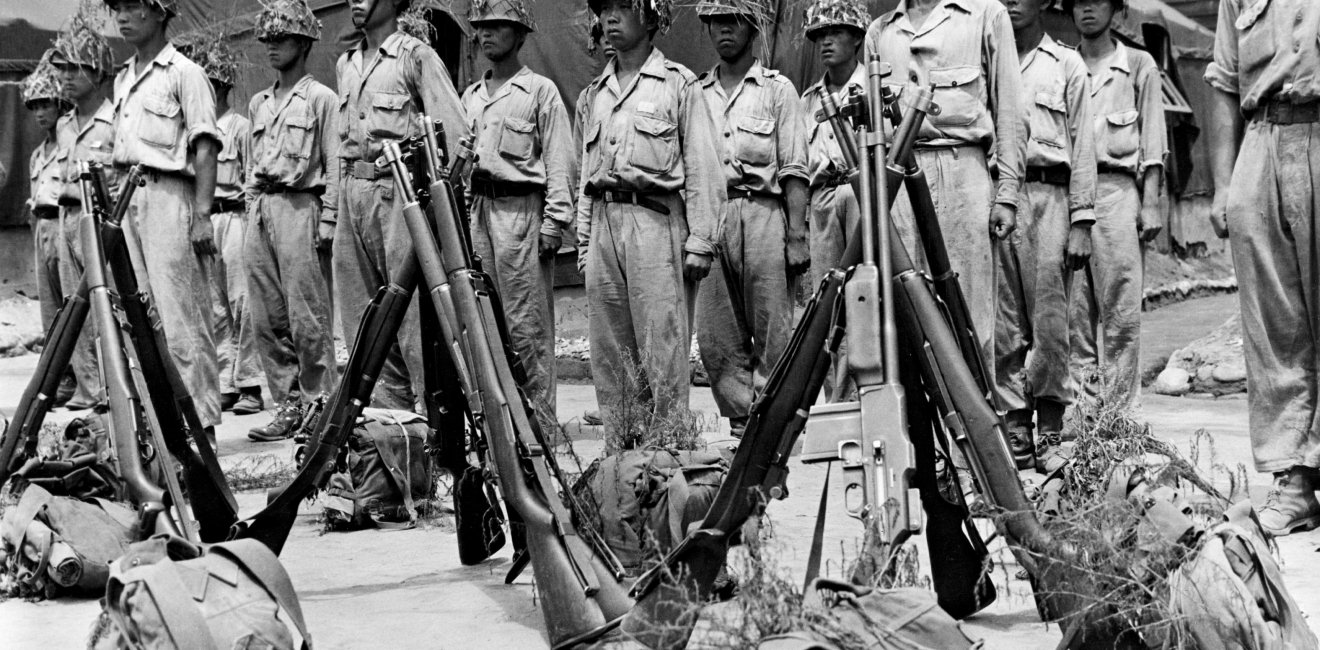The Battle of Ch’unch’on
It is long overdue that the South Korean story of the Korean War be provided, Jiyul Kim and Sheila Miyoshi Jager start with the Battle of Ch’unch’on.

A blog of the History and Public Policy Program
It is long overdue that the South Korean story of the Korean War be provided, Jiyul Kim and Sheila Miyoshi Jager start with the Battle of Ch’unch’on.

The opening days of the Korean War were catastrophic for the South Korean army. Undermanned, underequipped, and undertrained, the rapid disintegration of the South Korean army is an oft told tale. The one well-known exception was the 1st Division under the command of General Paik Sun Yup (Paek Sŏn-yŏb), whose legendary status is richly deserved, that defended the main approach to Seoul and the North’s main effort without falling apart.[1] But there is an even greater feat of battlefield performance during those opening days that is not as well-known and arguably had a greater impact on disrupting the North Korean plan of attack and conquest. This was the defense of Ch’unch’ŏn by the 6th Division.
In Brothers At War, Jager briefly described the battle and noted that the successful delaying action of the 6th Division “threw off the NKPA’s timeline and probably bought time for the establishment of the Pusan perimeter and the arrival of UN reinforcements.” Soviet General and ambassador to North Korea Shtykov reported that “the invasion ran into trouble from the beginning [due to the severe terrain] and especially the unexpected courageous defense of the ROK 6th Division at Ch’unch’ŏn.”[2] Allan Millett noted how the battle demonstrated that the South Korean army could fight “if commanded well and employed with good sense,” although he does not make a connection to the operational impact of the battle on North Korean plans. [3]
The specific way in which the Battle of Ch’unch’ŏn threw off the North Korean plans is more clearly described in the official South Korean history of the Korean War. It observed that the plan for NK II Corp to rapidly secure Ch’unch’ŏn and advance westward to envelop Seoul from the south was completely wrecked by the 6th Division’s stubborn defenses. Furthermore, the 6th Division exacted a heavy toll in men and equipment and its effective resistance beyond Ch’unch’ŏn continued to severely hamper the advance of NK forces. It mentions that the North Korean army’s Director of Operations, Yu Sŏng-ch’ŏl, later recalled how he personally tried to intervene and failed to get II Corps to overcome the stiff resistance that stalled its advance.[4]
In September 2017, the South Korean Ministry of Defense’s Institute for Military History issued a revision of the narrative for the Battle of Ch’unch’ŏn in volume 2 of its monumental 11-volume history of the Korean War published between 2004 and 2013. The reason for the revision was to publish the results of an investigation to review perhaps the most famous act of heroism from the war for South Koreans. Major Shim Il, then a 2nd Lieutenant, was an antitank platoon leader in the antitank company of 6th Division’s 7th Regiment that defended Ch’unch’ŏn city. Since the 1970s, “Major Shim Il (Shim Il soryŏng)” became a household name when his battlefield exploits were widely publicized. Lieutenant Shim’s destruction of a half dozen North Korean self-propelled guns (mistaking them for tanks) at two key moments in the battle had decisive impact on the flow of the battle by stopping the North Korean forces and raising the sagging morale of his comrades with his success. What grabbed the public’s imagination and made him iconic was his decision to act as a “human bullet” when his antitank guns proved ineffective against the vehicle’s armor. He led a small group of volunteer “human bullets” to climb the vehicles and destroy them with grenades and Molotov cocktails. [5]
Major Shim personified patriotic and martial virtues as well as the tragedy and sacrifice of the nation and its people in the Korean War. His exploits are part of primary school curriculum. His statues prominently stand near the battlefield and at the Korean Military Academy, his alma mater. He was chosen as the first of the monthly Patriotic Hero of the Korean War that the South Korean Ministry of Patriots and Veterans Affairs has selected since 2011.
The September 2017 revision was necessitated by an explosive claim made in June 2016 by retired general Yi Tae-yong, a Korean War hero in his own right who had served in the same regiment as Shim and participated in the Battle of Ch’unchŏn. Gen. Yi claimed that Shim’s exploits had been fabricated and that Shim, far from being a hero, was a coward who had run away from the enemy. Predictably, the accusation touched off much public anguish and debate in South Korea. Most dramatically, it publicly pitted the South Korean Army History Office that supported the accusation based on its investigation, against the Ministry of Defense’s Institute of Military History that found the allegations to be unfounded based on its own investigation. In September 2016, the Ministry of Defense formed a special investigative committee, the Committee to Confirm the Truth of Major Shim’s Wartime Record (ko shim il soryŏng kongjŏk hwag’in wiwŏnhoe), composed of members from both history offices, to get to the bottom. The committee announced in April 2017 that its members unanimously agreed in confirming Maj. Shim’s heroic exploits, with some corrections, based on new documentary evidence that they had discovered. The September 2017 revision mentioned above was the formal outcome. The Shim affair is of interest on three levels: to correct the historical details of one of the most important battles of the Korean War; to appreciate the political and cultural relevance of Shim and other recognized heroes as symbolic figures of national importance; and finally, to understand the complexity of war memory, especially in the service of the state.[6]
The Battle of Ch’unch’ŏn and the record of the South Korean 6th Division in the opening weeks of the war deserve more coverage and recognition as an important contributing factor to how the war developed toward the successful establishment of the Pusan Perimeter. Equally important is for the 6th Division’s record to counter the uniformly disparaging interpretation of the South Korean army’s performance. Indeed, it is long overdue that a more complete and balanced coverage on the South Korean story of the war be provided in English scholarship. The final subject of our series on Sources & Methods provides another example of this neglected story.
[1] General Paek celebrated his 99th birthday on November 20, 2019. Since the publication of his widely known 1989 memoir of the Korean War which has also been translated into English as From Pusan to Panmunjom (Brassey, 1992), Gen. Paek has put out two 3-volume set of Korean War memoir in 2010-2011 and 2016-2017. The 2010-2011 set titled Shoot Me If I Retreat: Memory of 1,128 Days [내가 물러서면 나를 쏴라: 1128일의 기억] (Seoul: Chung’ang ilbosa, 2010-2011) covers the entire war. The 2016-2017 set focuses on the first year of the war until the start of the Armistice talks and is intended as his warning to the nation not to repeat the mistakes and failures of that year that almost led to catastrophe. Paek Sŏn-yŏp, Paek Sŏn-yŏp’s Korean War Lessons [jingbirok] [백선엽의 6-25 전쟁 징비록], 3 volumes (Seoul: Ch’aekbot, 2016-2017). The title evokes a well-known 17th century first-person account of the Japanese invasion of Korea in the 1590s, Jingbirok (written by Ryu Sŏng-ryŏng in 1604), the purpose of which was to record Korea’s weaknesses and failures that led to the national disaster which was the Imjin Wars so that Korea may never repeat them. Jingbirok literally means a record of punishment and forbearance.
[2] Jager, Brothers At War, 79.
[3] Millett, They Came From the North, 95.
[4] Korea Institute of Military History, The Korean War, Vol. 1 (Univ of Nebraska Press, 2000), 207-208. Roy E. Appleman wrote that the North Korean 2nd Division suffered almost 40% casualty, U.S. Army in the Korean War: South to Naktong, North to Yalu (Center of Military History, 1992), 27.
[5] Institute for Military History, South Korean Ministry of Defense, “The Battle of Ch’unch’ŏn (Revised) – History of the Korean War Volume 2” [“춘천지구 전투 (수정문) – 6-25 전쟁사 제2권”] (Seoul: Institute for Military History 국방부 군사편찬연구소, September 2017). http://www.imhc.mil.kr/user/imhc/upload/pblictn/PBLICTNEBOOK_201801050142386560.pdf
[6] “Major Shim Il, a Korean War Hero,” KBS World Radio, 28 June 2012. http://rki.kbs.co.kr/service/contents_view.htm?lang=e&menu_cate=history&id=&board_seq=60785&page=21&board_code=
Choe Bo-sik, “The Uncomfortable Truth of a ‘Patriotic Hero’ [북 탱크를 부순 ‘호국영웅’의 불편한 진실],” Chosun ilbo 17 June 2016. https://news.chosun.com/site/data/html_dir/2016/06/16/2016061603416.html
O Tong-ryong, “There is no ‘Uncomfortable Truth’ of a Korean War Patriotic Hero! [6-25 호국영웅의 ‘불편한 진실’은 없다!,” Wŏlgan chosŏn, March 2017. http://monthly.chosun.com/client/news/viw.asp?ctcd=G&nNewsNumb=201703100052&page=6
Yi Ch’ŏl-jae, “Ministry of National Defense Concludes, Maj. Shim Il was a True Hero [“’가짜 영웅’ 논란 심일 소령, 진짜 영웅 맞다…국방부 결론”], Chung’ang ilbo, 12 Apr 2017. https://news.joins.com/article/21465602



A leader in making key foreign policy records accessible and fostering informed scholarship, analysis, and discussion on international affairs, past and present. Read more


The North Korea International Documentation Project serves as an informational clearinghouse on North Korea for the scholarly and policymaking communities, disseminating documents on the DPRK from its former communist allies that provide valuable insight into the actions and nature of the North Korean state. Read more


The Cold War International History Project supports the full and prompt release of historical materials by governments on all sides of the Cold War. Read more



